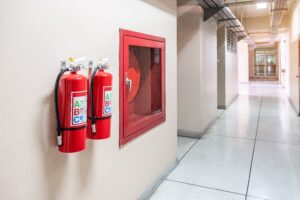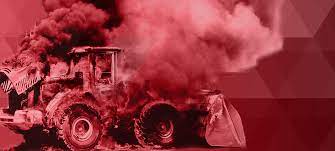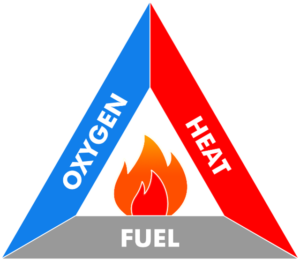
10 Tips for Fire Safety in Schools
This guide covers our Top 10 Tips for Fire Safety in Schools to ensure you haven’t missed off any of the really important, but easily overlooked facets of fire safety
Book your FREE, no-strings-attached Fire Safety Audit to ensure that you’re properly protected from the risk and comply with current fire safety legislation.
Get essential insights and updates
in fire safety – straight to your inbox!

Hydraulic lubricants have a spontaneous combustion temperature of as low as 250°C. In the event of a leak in the engine compartment, the oil can come in contact with surfaces above 600°C, which causes it to burst into flames immediately. With a constant supply of flammable liquid, fires can be extremely vicious.
When working in dusty environments typical of the waste management industry, dirt, and dust are built up in engine compartments. Due to the hot surfaces, the material can be heated to spontaneous combustion temperature and quickly spread to other parts of the compartment.
Regular checks of the engine bay components can help identify areas of wear. Worn hydraulic lines, electrical cables, and associated parts can be a sure sign of imminent failure, resulting in a fire. As the saying goes, “Forewarned is forearmed,” any parts replacements identified by a quick check can be actioned to ensure a fire is less likely to happen.
Regular checks of the engine bay components can help identify areas of wear. Worn hydraulic lines, electrical cables and associated parts can be a sure sign of imminent failure resulting in a fire. As the saying goes “Forewarned is forearmed” and any parts replacements identified by a quick check can be actioned to ensure a fire is less likely to happen.
Effective detection solutions are essential in identifying fires quickly when they occur. One of the best is a linear heat detection cable. This small and insignificant red cable has two wires parallel to each other, separated by heat-sensitive polymers that soften at a certain temperature, allowing the wires to touch, creating a short circuit that triggers an alarm and discharges the suppression system.
There are two main types of suppression agent: Powder and Foam.
One of the oldest engine bay suppression systems is powder. It displaces the oxygen in the engine bay and covers the components with a layer of solid particles. However, it has no cooling effects, so re-ignition is risky if the components are still hot enough. In addition, the agent is abrasive, corrosive, and very hard to clean away properly – which can harm the very engine bay it is trying to protect.
Foam is the best suppression agent. It is so effective because it removes all three elements required to start a fire in the first place – Heat, Fuel, and Oxygen. The liquid-based agent impregnates the accumulations of solid material, cools the hot surfaces, and displaces the oxygen by creating a thin film over the top of the material to suffocate the fire. It means that there is a significantly reduced chance of re-ignition.
In conclusion, regular checks and maintenance of mobile plant machinery are as necessary as suitable and effective detection and suppression systems. However, foam is the recommended option for suppression systems.
For more information on our market-leading solutions, contact us on +44 (0)1234 357357 or email sales@dev.blazequel.com.

This guide covers our Top 10 Tips for Fire Safety in Schools to ensure you haven’t missed off any of the really important, but easily overlooked facets of fire safety

Fires are often unpredictable, destructive, and can cause massive loss of life. Understanding how fire works can help us prevent it, predict it, and control it. One of the most

Keep your festive season merry and bright with essential Christmas Fire Safety tips from Blazequel. From illuminating your home safely with holiday lights to ensuring your Christmas tree doesn’t become
Video Smoke Detection is perfect for a fast response to fires in high roofed buildings and harsh operating conditions.
Watch Smokecatcher detect smoke in an MSW storage building. The smoke is coming through from a fire in the adjoining storage area.
Watch Smokecatcher detect a fire in an SRF Storage bunker. Sadly, the alarm wasn’t responded to and the site lost a 4hr window of opportunity between smoke detection and flames appearing.
Video Smoke Detection overcomes the risks of stratification and other challenges for early fire detection in logistics and storage facilities.
Watch Fire Rover detect and suppress a fire in the waste bunker at an EFW facility!
See how the Fire Rover detects and suppresses this fire at a clients tipping hall. Note how the smok is spreading out at low leve, rather than rising. This is called ‘stratification’ and is one of the many reasons why roof-mounted smoke detection systems like beam detectors and HSSD is not suitable for many recycling applications.
Watch the Fire Rover detect and suppress a fire at a battery storage facility. This targeted and intellegent control makes the Fire Rover particularly well suited to high hazard storage applications.
Watch the Fire Rover tackle a battery fire in a tipping hall. Note how the exploding battery cells start three separate fires, which the operator individually suppresses (whilst avoiding the site operators in the vicinity).
Get essential insights and updates in fire safety – straight to your inbox!
